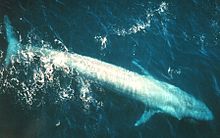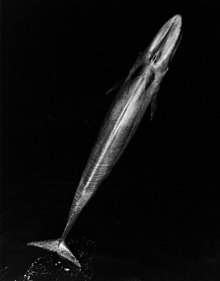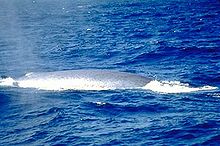 The blue whale (Balaenoptera musculus) is a marine mammal belonging to the baleen whales (Mysticeti). At 30 metres (98 ft) in length and 170 tonnes (190 short tons) or more in weight, it is the largest known animal ever to have existed.
The blue whale (Balaenoptera musculus) is a marine mammal belonging to the baleen whales (Mysticeti). At 30 metres (98 ft) in length and 170 tonnes (190 short tons) or more in weight, it is the largest known animal ever to have existed.Long and slender, the blue whale's body can be various shades of bluish-grey dorsally and somewhat lighter underneath. There are at least three distinct subspecies: B. m. musculusof the North Atlantic and North Pacific, B. m. intermedia of the Southern Ocean and B. m. brevicauda (also known as the pygmy blue whale) found in the Indian Ocean and South Pacific Ocean. B. m. indica, found in the Indian Ocean, may be another subspecies. As with other baleen whales, its diet consists almost exclusively of small crustaceans known as krill.
Blue whales were abundant in nearly all the oceans on Earth until the beginning of the twentieth century. For over a century, they were hunted almost to extinction by whalers until protected by the international community in 1966. A 2002 report estimated there were 5,000 to 12,000 blue whales worldwide, located in at least five groups. More recent research into the Pygmy subspecies suggests this may be an underestimate. Before whaling, the largest population was in the Antarctic, numbering approximately 239,000 (range 202,000 to 311,000). There remain only much smaller (around 2,000) concentrations in eacha of the eastern North Pacific, Antarctic, and Indian Ocean groups. There are two more groups in the North Atlantic, and at least two in the Southern Hemisphere.
Taxonomy
Taxonomy
Blue whales are rorquals (family Balaenopteridae), a family that includes the humpback whale, the fin whale, Bryde's whale, the sei whale, and the minke whale. The familyBalaenopteridae is believed to have diverged from the other families of the suborder Mysticetias long ago as the middle Oligocene. It is not known when the members of those families diverged from each other.
The blue whale is usually classified as one of eight species in the genus Balaenoptera; one authority places it in a separate monotypic genus, Sibbaldus, but this is not accepted elsewhere. DNA sequencing analysis indicates that the blue whale is phylogeneticallycloser to the sei whale (Balaenoptera borealis) and Bryde's whale (Balaenoptera brydei) than to other Balaenoptera species, and closer to the humpback whale (Megaptera) and the gray whale (Eschrichtius) than to the minke whales (Balaenoptera acutorostrata and Balaenoptera bonaerensis). If further research confirms these relationships, it will be necessary to reclassify the rorquals.
There have been at least 11 documented cases of blue/fin hybrid adults in the wild. Arnason and Gullberg describe the genetic distance between a blue and a fin as about the same as that between a human and a gorilla. Researchers working off Fiji believe they photographed a hybrid humpback/blue whale.
The first published description of the blue whale comes from Robert Sibbald's Phalainologia Nova (1694). In September 1692, Sibbald found a blue whale that had stranded in the Firth of Forth—a male 78-feet-long—which had "black, horny plates" and "two large apertures approaching a pyramid in shape".
The specific name musculus is Latin and could mean "muscle", but it can also be interpreted as "little mouse". Carl Linnaeus, who named the species in his seminal Systema Naturae of 1758, would have known this and may have intended the ironic double meaning. Herman Melville called this species sulphur-bottom in his novel Moby-Dick due to an orange-brown or yellow tinge on the underparts from diatom films on the skin. Other common names for the blue whale have included Sibbald's rorqual (after Sibbald, who first described the species), the great blue whale and the great northern rorqual. These names have now fallen into disuse. The first known usage of the term blue whale was in Melville's Moby-Dick, which only mentions it in passing and does not specifically attribute it to the species in question. The name was really derived from the Norwegian blåhval, coined by Svend Foyn shortly after he had perfected the harpoon gun; the Norwegian scientist G. O. Sars adopted it as the Norwegian common name in 1874.
Authorities classify the species into three or four subspecies: B. m. musculus, the northern blue whale consisting of the North Atlantic and North Pacific populations, B. m. intermedia, the southern blue whale of the Southern Ocean, B. m. brevicauda, the pygmy blue whale found in the Indian Ocean and South Pacific, and the more problematic B. m. indica, the great Indian rorqual, which is also found in the Indian Ocean and, although described earlier, may be the same subspecies as B. m. brevicauda.
Description and behaviour
Description and behaviour
The blue whale has a long tapering body that appears stretched in comparison with the stockier build of other whales. The head is flat, U-shaped and has a prominent ridge running from theblowhole to the top of the upper lip. The front part of the mouth is thick with baleen plates; around 300 plates (each around one metre (3.2 ft) long) hang from the upper jaw, running 0.5 m (1.6 ft) back into the mouth. Between 70 and 118 grooves (called ventral pleats) run along the throat parallel to the body length. These pleats assist with evacuating water from the mouth after lunge feeding (see feeding below).
The dorsal fin is small, ranging in height from 8–70 centimeters (3.1–28 in) (usually 20–40 centimeters (7.9–16 in)) and averaging about 28 centimetres (11 in). It is visible only briefly during the dive sequence. Located around three-quarters of the way along the length of the body, it varies in shape from one individual to another; some only have a barely perceptible lump, but others may have prominent and falcate (sickle-shaped) dorsals. When surfacing to breathe, the blue whale raises its shoulder and blowhole out of the water to a greater extent than other large whales, such as the fin or sei whales. Observers can use this trait to differentiate between species at sea. Some blue whales in the North Atlantic and North Pacific raise their tail fluke when diving. When breathing, the whale emits a spectacular vertical single-column spout up to 12 metres (39 ft), typically 9 metres (30 ft). Its lung capacity is 5,000 litres (1320 U.S. gallons). Blue whales have twin blowholes shielded by a large splashguard.
The flippers are 3–4 metres (9.8–13 ft) long. The upper sides are grey with a thin white border; the lower sides are white. The head and tail fluke are generally uniformly grey. The whale's upper parts, and sometimes the flippers, are usually mottled. The degree of mottling varies substantially from individual to individual. Some may have a uniform slate-grey color, but others demonstrate a considerable variation of dark blues, greys and blacks, all tightly mottled.
Blue whales can reach speeds of 50 kilometres per hour (31 mph) over short bursts, usually when interacting with other whales, but 20 kilometres per hour (12 mph) is a more typical traveling speed. When feeding, they slow down to 5 kilometres per hour (3.1 mph).
Blue whales most commonly live alone or with one other individual. It is not known how long traveling pairs stay together. In locations where there is a high concentration of food, as many as 50 blue whales have been seen scattered over a small area. They do not form the large, close-knit groups seen in other baleen species.
Size
The blue whale is the largest animal ever known to have lived. The largest known dinosaur of theMesozoic Era was Argentinosaurus, which is estimated to have weighed up to 90 metric tons (99 short tons).
Blue whales are difficult to weigh because of their size. As is the case with most large whales targeted by whalers, adult blue whales have never been weighed whole, but cut up into manageable pieces first. This caused an underestimate of the total weight of the whale, due to the loss of blood and other fluids. As a whole, blue whales from the Northern Atlantic and Pacific appear to be smaller on average than those from sub-Antarctic waters. Nevertheless, measurements between 150–170 metric tons (170–190 short tons) were recorded of animals up to 27 metres (89 ft) in length. The weight of an individual 30 metres (98 ft) long is believed by the American National Marine Mammal Laboratory (NMML) to be in excess of 180 metric tons (200 short tons). The largest blue whale accurately weighed by NMML scientists to date was a female that weighed 177 metric tons (195 short tons).
There is some uncertainty about the biggest blue whale ever found, as most data came from blue whales killed in Antarctic waters during the first half of the twentieth century, which were collected by whalers not well-versed in standard zoological measurement techniques. The heaviest whale ever recorded weighed in at approximately 190 metric tons (210 short tons).The longest whales ever recorded were two females measuring 33.6 metres (110 ft) and 33.3 metres (109 ft), although in neither of these cases was the piecemeal weight gathered.The longest whale measured by scientists at the NMML was a 29.9 metres (98 ft),female caught in the Antarctic by Japanese whalers in 1946–47. Lieut. Quentin R. Walsh, USCG, while acting as whaling inspector of the factory ship Ulysses, verified the measurement of a 30 m (98 ft) pregnant blue whale caught in the Antarctic in the 1937–38 season. The longest reported in the North Pacific was a 27.1 metres (89 ft) female taken by Japanese whalers in 1959, and the longest reported in the North Atlantic was a 28.1 metres (92 ft) female caught in the Davis Strait.
Due to its large size, several organs of the blue whale are the largest in the animal kingdom. A blue whale's tongue weighs around 2.7 metric tons (3.0 short tons) and, when fully expanded, its mouth is large enough to hold up to 90 metric tons (99 short tons) of food and water. Despite the size of its mouth, the dimensions of its throat are such that a blue whale cannot swallow an object wider than a beach ball. Its heart weighs 600 kilograms (1,300 lb) and is the largest known in any animal. A blue whale'sthoracic aorta is estimated to be 23 centimetres (9.1 in) in diameter. During the first seven months of its life, a blue whale calf drinks approximately 400 litres (110 US gal) of milk every day. Blue whale calves gain weight quickly, as much as 90 kilograms (200 lb) every 24 hours. Even at birth, they weigh up to 2,700 kilograms (6,000 lb)—the same as a fully grown hippopotamus. Blue whales have relatively small brains, only about 6.92 kilograms (15.26 lb) , about 0.007% of its body weight. The blue whale penis is the largest penis of any living organism. The reported average length varies but is usually mentioned to have an average penis length of 8 feet (2.4 m) to 10 feet (3.0 m).
Feeding
Blue whales feed almost exclusively on krill, though they also take small numbers of copepods.The species of this zooplankton eaten by blue whales varies from ocean to ocean. In the North Atlantic, Meganyctiphanes norvegica, Thysanoessa raschii, Thysanoessa inermis and Thysanoessa longicaudata are the usual food;in the North Pacific, Euphausia pacifica, Thysanoessa inermis, Thysanoessa longipes, Thysanoessa spinifera, Nyctiphanes symplex and Nematoscelis megalops; and in the Southern Hemisphere, Euphausia superba, Euphausia crystallorophias,Euphausia valentini, and Nyctiphanes australis.
An adult blue whale can eat up to 40 million krill in a day. The whales always feed in the areas with the highest concentration of krill, sometimes eating up to 3,600 kilograms (7,900 lb) of krill in a single day. The daily energy requirement of an adult blue whale is in the region of 1.5 million kilocalories. Their feeding habits are seasonal. Blue whales gorge on krill in the rich waters of the Antarctic before migrating to their breeding grounds in the warmer, less-rich waters nearer the equator. The blue whale can take in up to 90 times as much energy as it expends, allowing it to build up considerable energy reserves.
Because krill move, blue whales typically feed at depths of more than 100 metres (330 ft) during the day and only surface-feed at night. Dive times are typically 10 minutes when feeding, though dives of up to 20 minutes are common. The longest recorded dive is 36 minutes. The whale feeds by lunging forward at groups of krill, taking the animals and a large quantity of water into its mouth. The water is then squeezed out through the baleen plates by pressure from the ventral pouch and tongue. Once the mouth is clear of water, the remaining krill, unable to pass through the plates, are swallowed. The blue whale also incidentally consumes small fish, crustaceans and squid caught up with krill.

This work is licensed under a Creative Commons Attribution-ShareAlike 3.0 Unported License.




 03:44
03:44
 Planet Worldwide
Planet Worldwide







 Posted in:
Posted in:
0 comments:
Post a Comment